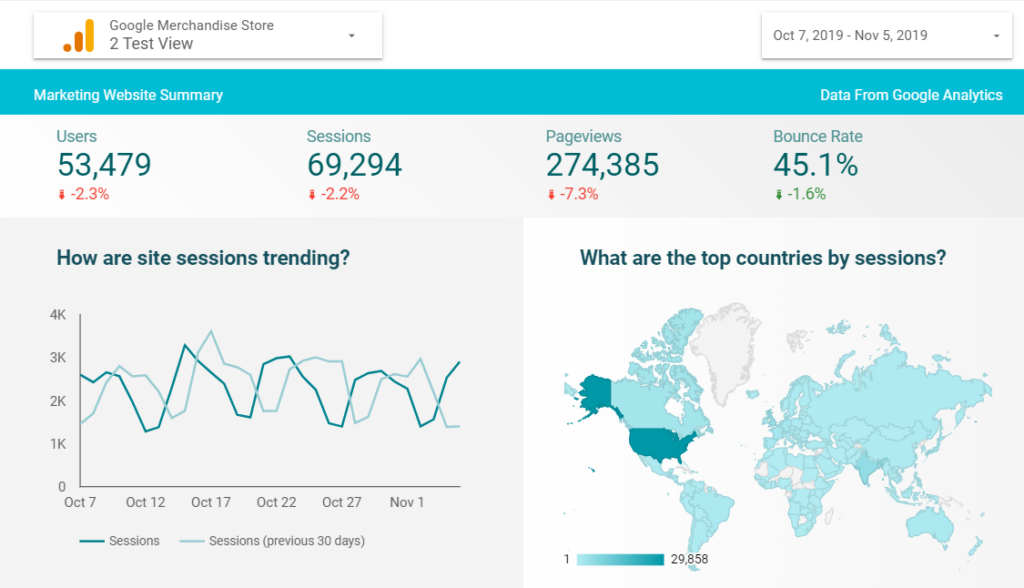-
 12 min. read
12 min. read
-
 Macy Storm
Macy Storm Senior Content Creator
Senior Content Creator
- Macy is a marketing writer with over five years of experience creating content for dozens of industries including food and beverage, home services, and education. She also specializes in creating SEO and PPC content. Her work has been featured by Search Engine Journal, HubSpot, Entrepreneur, Clutch, and more. In her free time, Macy enjoys trying new crafts and reading comic books.
When you invest in digital marketing, it’s essential to monitor your campaigns to ensure you’re driving a positive return on investment (ROI) for your business. With marketing analytics, you can see how your strategies perform and where you can make improvements. On this page, we’ll answer the question, “What is marketing analytics?” and share the definition of marketing analytics.
We’ll also dive into why analytics in marketing takes up 6.5% of marketing budgets and provide you with three marketing analytics best practices.
If you want to learn more about how to use your marketing data, sign up for our newsletter to stay on top of the latest trends and strategies.
Time to Level Up Your Sales
Our long list of services helps you grow every aspect of your business with marketing strategies that are proven to increase bottom-line metrics like revenue and conversions.
In the past 5 years, we’ve managed more than 14.9 MILLION transactions across our client base.
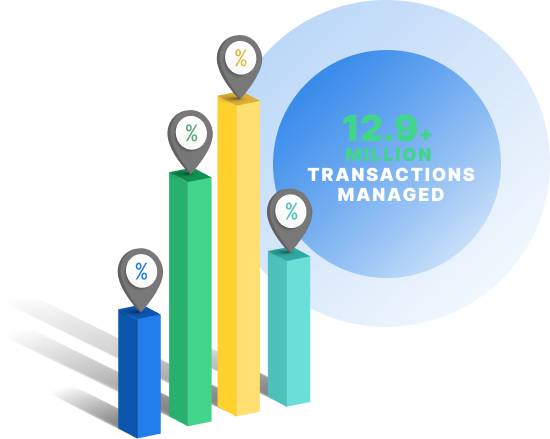
What is marketing analytics?
Marketing analytics is the practice of gathering, managing, and analyzing data from your marketing campaigns. It involves processes and technologies that allow your business to see how your campaigns are performing and determine how you can reoptimize them in the future.
“Marketing analytics puts your data into context. You see the data of your brand and your market, which gives you a complete picture of how your marketing efforts influence your revenue.”
These data points help you understand the bigger picture of your marketing efforts.
With marketing analytics, you compare the cost of your marketing to the revenue driven. Use this data to analyze your marketing efforts and ensure you’re spending each dollar for your company effectively.
Prices for marketing analytics range from $250 to $750 per month.
How does marketing analytics work?
Now that you can define marketing analytics, we’ll cover a typical follow-up question: “How does marketing analytics work?” Many people make the mistake of saying that marketing metrics and marketing analytics are the same. Marketing analytics is made up of marketing metrics.
These metrics are individual data points you measure for each strategy. If you look at the click-through rate (CTR) or conversion rate of a tactic, you’re looking at the marketing metrics for that strategy.

With marketing analytics, you’re compiling all those metrics from each strategy into one place to get an overall scope of your campaign. Instead of looking at one strategy and how it performs, you take all your strategies (and their respective metrics) and compile them in one place.
Marketing analytics helps you determine your overall marketing effectiveness rather than the effectiveness of individual tactics. Marketing analytics will help you consolidate your data to see the bigger picture. When you know how to measure marketing performance, you can make improvements to drive better results.
Why is marketing analytics important?
You may think that having your marketing metrics is enough, but knowing how to measure overall marketing performance is crucial to your business’s success.
Let’s take a look at four reasons analytics in marketing is essential.
1. Marketing analytics summarizes every marketing effort
Marketing analytics is vital to your business because it thinks about all your marketing efforts. It doesn’t look at individual metrics or strategies, but rather, all this information together. It helps you gain a more significant understanding of your marketing strategy.
That matters because many strategies influence each other. You can use your social media profile, for example, to promote your blogs and drive traffic to your site through pay-per-click (PPC) ads. You don’t want to make decisions based on one strategy or platform.
Since these methods often work together to market your business, it’s valuable to look at the entire campaign through marketing analytics.
2. Marketing analytics demonstrates which strategies work
When you look at your marketing campaign, it’s crucial to understand how each method works with one another and influences your overall strategy. With marketing analytics, you see an overview of your marketing methods and understand how your strategies drive results for your business. If you were to look at each strategy by itself, you wouldn’t fully understand its impact.
For example, you’d look at your tactics, like improving page speed and user experience, and see how they impact your SEO ranking.
With analytics in marketing, you look at your SEO strategy, SEO analytics, and see how they affect your overall online marketing campaign. When you look at your methods together, it helps you see how they work together.

Your social media strategy may play a fundamental role in helping your content marketing and video marketing efforts, for example, but if you look at your individual channel performance, you may not see the connection. By looking at your marketing analytics, you’ll understand which strategies work well and work well together.
Your data helps you determine why those strategies work so that you can improve them and apply your takeaways to other tactics.
3. Marketing analytics shows trends over time
Marketing analytics enables you to track trends over time. You can see how your marketing campaign changes as you evolve your tactics, adopt new strategies, and more. It’s essential to monitor your entire marketing campaign to understand how it changes over time.
Many factors influence your business’s performance online, including changes in the season and consumer behavior. When you monitor your overall campaign performance, you can spot trends and see how those trends influence your campaign. This proactive approach allows you to adapt your campaigns to drive better results for your business.
4. Marketing analytics help you plan for the future
Analytics in marketing enables you to prepare for future marketing strategies. When you can monitor your entire marketing campaign, you can improve your future approaches. You’ll learn what works and what doesn’t work for your business.
Plus, you’ll gain a better understanding of how different strategies impact one another. When you can see the bigger picture of your marketing campaign, you can plan your future marketing strategies better.
A step-by-step guide to the marketing data analytics process
Now that we’ve covered what marketing analytics is and how it can benefit your business, you’re probably wondering what the analytics process looks like. Here are four steps you can follow to put your business analytics into action!
1. Choose your metrics
The first step in the analytics process is choosing the marketing metrics you want to check. After all, your data won’t just magically appear — you’ll have to track specific key performance indicators (KPIs) that show you how your marketing is performing.
There are a few metrics you’ll want to consistently look at, like conversion rate and ROI. But for the most part, you’ll want to track different KPIs depending on the type of marketing you’re looking at.
For example, if you’re analyzing your email marketing, open rate is an important metric to look at.
And if you’re tracking web traffic, you’ll want to keep up with things like bounce rate and average time on site.
2. Gather your data
Once you know which metrics you want to track, it’s time to actually begin tracking them. You can do this manually, but it’s best to use digital tools to help you. For instance, you can use Google Analytics to help you track metrics related to traffic on your website.
You won’t be able to start analyzing your data the second it comes in.
For your analytics to be effective, you’ll need to wait until you have enough data to see patterns in. Depending on the time frame you want to look at, that could mean you need to wait anywhere from a few weeks to several months.
Eventually, though, you’ll have gathered enough data to gain insights from.
3. Organize the data
Now that you have all the data, it’s almost time to perform your analysis — but still not quite. First, you have to organize that data. After you first gather it, your data isn’t very well-organized.
You have a whole database of numbers, but those numbers don’t mean anything until they’re arranged into patterns.
That’s what the organization step is for. As with the previous step, you can do this manually, but it’s not advisable. It’s best to get a data management platform (DMP) or business intelligence (BI) software to help you arrange the information.
4. Assess your information
With your data gathered and organized, you can finally assess it for valuable business insights. You’ll want to look for trends or patterns that reflect the way your marketing has influenced leads and conversions. To that end, it can be helpful to create charts and graphs.
Whatever you learn from your data, you can then turn around and apply to your marketing.
If you find that a particular tactic is driving powerful results, consider using that tactic across more of your campaigns. If you find that your sales are low in a given season, consider upping your marketing game during that season.
Marketing analytics tips and best practices
If you want to start using marketing analytics to your business’s benefit, take a look at these three best practices.
1. Define your most valuable metrics
Since metrics play a fundamental role in marketing analytics, you’ll want to decide which metrics to use to monitor the success of your overall marketing campaign. When analyzing multiple platforms or strategies, you want to specify the metrics you’ll look at when assessing their performance. Your analytics aren’t useful if you’re monitoring data that doesn’t matter to your business.
Plus, you want to avoid getting lost in all that information.
To help you choose the right metrics, define your goals. What’s your overall marketing goal for your campaigns? When you have your goals, you’ll know which metrics to monitor for all your campaigns.
If you partner with a digital marketing company like WebFX, we can help you define your most valuable metrics based on your goals, as well as monitor and improve those metrics to help your business reach its goals.
2. Ensure you’re using high-quality data
Another marketing analytics best practice is using high-quality data. If you want to get the most out of marketing analytics, you need to use quality data to ensure you’re getting the best and most accurate results and takeaways. You want to pull data from all your marketing methods.
Compiling all your data ensures that you have a well-rounded profile. You obtain data that accurately represents all your different strategies.
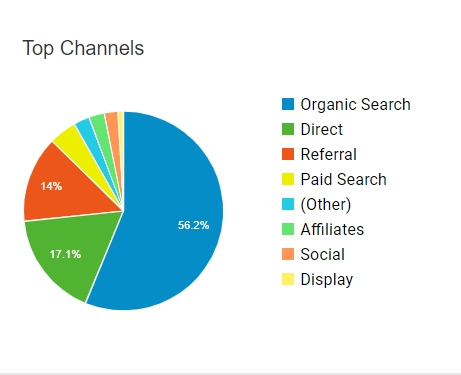
You also want to ensure you’re using up-to-date data. You don’t want to analyze months-old data.
To get the most out of your marketing analytics, use the latest data, and pull it from all your strategies to get an accurate picture. When you partner with a digital marketing company like WebFX, we’ll help you identify high-quality data to ensure you’re using the right data for your marketing analytics, so you can improve your overall campaign.
3. Segment your data
Another way to improve your marketing analytics is to segment your data. Segmentation doesn’t make sense for every type of analytics, of course. But if you’re tracking data about your potential customers, it can be a useful tool.
It’s hard to learn too much about your audience if all your potential customers are bundled together haphazardly.
But when you segment them into different groups, it can help you pick out new patterns you might have otherwise missed.
You can segment people by different traits. Common demographics like age and gender are one way to do it. You can also segment by geographical location, or even by user behaviors on your website.
4. Use analytics visualization tools
Analytics visualization tools will help you understand your data better. It’s a great marketing analytics best practice because it visually presents your data so that anyone can understand it. Visualizations, like bar graphs and pie charts, help you present data to people who are familiar and unfamiliar with your data.
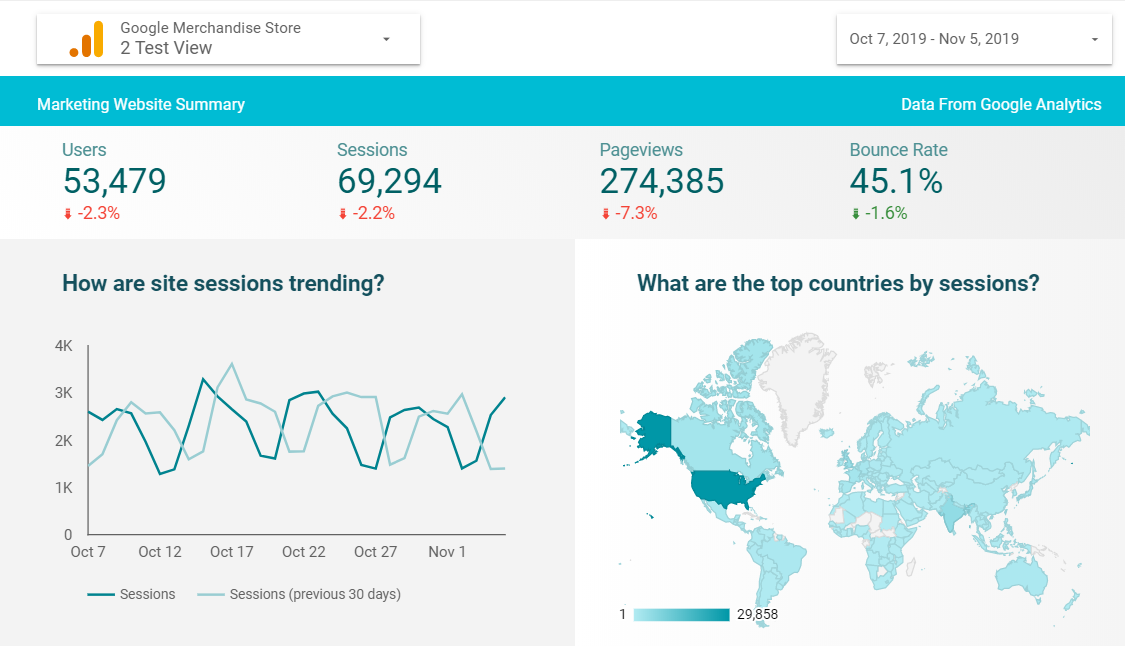
Visualization tools create presentations of your data.
If you use the right data visualization tool, you can create custom data presentations. Custom data presentations allow you to present your data in the best possible way for your business.
Many marketing companies, like WebFX, utilize data visualization tools to help present data in a clear and concise manner. They often use tools like Google Data Studio to make it easy for you to see your data and understand it.
5. Note what works — and what doesn’t
Analytics is largely about finding what works best in your marketing and then implementing those tactics going forward. But many businesses get so caught up in finding what works that they forget to pay attention to what doesn’t work.
When you conduct your marketing analysis, be sure to keep an eye out for any campaigns, tactics, or strategies that aren’t benefiting your company. Sometimes it’s easy to assume you should be doing a particular tactic, but if it isn’t working for you, there’s no point in wasting resources on it.
For example, maybe you’re testing a particular social media ad campaign, but it’s costing more than it’s earning.
You can try reoptimizing it to drive better results, but if nothing works, it might be best to simply stop doing it. Otherwise, you’re needlessly dragging down your ROI.
Meet MarketingCloudFX:
One platform tracking countless metrics and driving stellar results.
Learn More About Our Proprietary Software
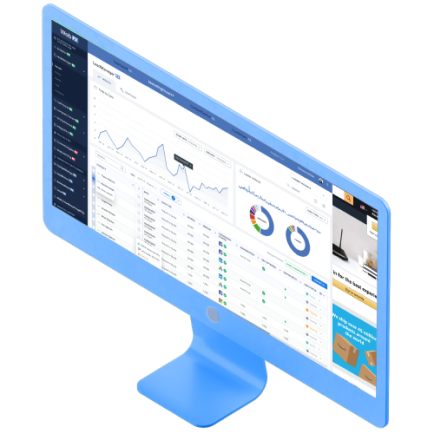
Start using marketing analytics to create better marketing campaigns today
Marketing analytics will help you generate more effective campaigns for your business. You’ll gain a greater understanding of how your marketing strategies work, so you can improve them to drive better results.
At WebFX, we have the tools you need to understand your marketing analytics.
Our software suite, MarketingCloudFX, helps you monitor the performance of your campaigns and their ROI. It comes with built-in marketing tools for managing leads, personalizing web experiences, and more, so you can manage your entire campaign in one place.
Ready to see how marketing analytics will help your business improve your campaigns and grow? Contact us online or call us today at 888-601-5359 to speak with a strategist about improving marketing campaigns.
-
 Macy is a marketing writer with over five years of experience creating content for dozens of industries including food and beverage, home services, and education. She also specializes in creating SEO and PPC content. Her work has been featured by Search Engine Journal, HubSpot, Entrepreneur, Clutch, and more. In her free time, Macy enjoys trying new crafts and reading comic books.
Macy is a marketing writer with over five years of experience creating content for dozens of industries including food and beverage, home services, and education. She also specializes in creating SEO and PPC content. Her work has been featured by Search Engine Journal, HubSpot, Entrepreneur, Clutch, and more. In her free time, Macy enjoys trying new crafts and reading comic books. -

WebFX is a full-service marketing agency with 1,100+ client reviews and a 4.9-star rating on Clutch! Find out how our expert team and revenue-accelerating tech can drive results for you! Learn more
Try our free Marketing Calculator
Craft a tailored online marketing strategy! Utilize our free Internet marketing calculator for a custom plan based on your location, reach, timeframe, and budget.
Plan Your Marketing Budget

Maximize Your Marketing ROI
Claim your free eBook packed with proven strategies to boost your marketing efforts.
Get the GuideTry our free Marketing Calculator
Craft a tailored online marketing strategy! Utilize our free Internet marketing calculator for a custom plan based on your location, reach, timeframe, and budget.
Plan Your Marketing Budget

